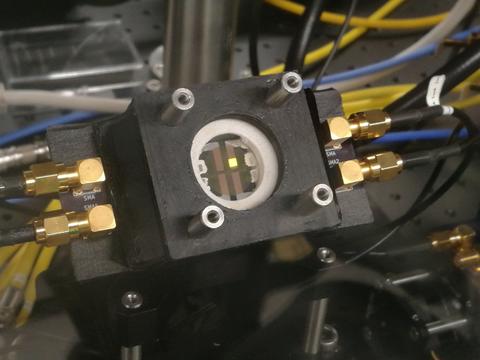Summary
Emerging technology extends beyond electrical performance and seeks to take advantage of alternative energy and information carriers in materials, such as excitons and spin. To accommodate these carriers, novel semiconducting materials are often employed to tune the efficiency of specific carrier dynamics. Our challenge is to tie macroscopic device performance in these materials to physical understanding of quantum-level processes related to alternative carriers to provide the scientific understanding to drive technological development.
Description

Organic light emitting diode, light output is modulated through magnetic control of exciton states
Our approach toward establishing connections between the application space and physical phenomena includes developing electrical/optical devices and measurements that can be used for physical measurement, physical measurements that can be applied to real devices, and device design that can be tuned to demonstrate the results of physical phenomena at the quantum scale.
Projects and capabilities
Room temperature excitons:
Specialized device fabrication and combined electrical/optical/magnetic measurement suite to demonstrate relationship of device performance to exciton dynamics.
Excitons are an energy carrying species made up of a bound electron-hole pair. High binding energy excitons, with energy above 25 meV, can live longer at room temperature and have demonstrated quantum phenomena at long timescales in device output. Organic semiconductors form excitons with binding energies above 300 meV, making it possible to manipulate these states for timescales on the order of microseconds at room temperature.
The sub-microsecond dynamics of singlet and triplet populations of excitons impact the performance of photovoltaic (OPV) and light emitting diode (OLED) devices. We have developed a measurement suite that combines advanced device design, magnetic manipulation of exciton populations, electro-reflectance, and in-depth electrical analysis of OLED and OPV devices to allow for the experimental separation of competing energetic pathways, such as charge-transfer exciton states, in order to probe the influence triplet-singlet state dynamics.
Dynamic interactions in organic semiconductors:
Advanced electrical measurements, sample and device design to demonstrate dynamic processes in organic semiconductors.
Due to weak coupling between molecules in the solid state, organic semiconductors exhibit a unique charge carrier-phonon interaction. The charges do not scatter off phonons as in a band conduction system (i.e. Si or metals), but rather are “pushed around” by the phonons as energetic coupling is tuned through molecular displacements. Identifying the types of molecular motions and phonons with a large impact on charge-carrier transport through a crystal can be used to design better dynamic molecular structures and can be extended to phonon interactions with spin or excitons.
The dynamics of charge transport occurs at timescales much faster than device output, requiring careful device and experimental design to probe. Our measurement capabilities combine anisotropic charge transport and phonon properties in order to determine molecular displacement and impact on transport pathways within the plane of single crystals.

